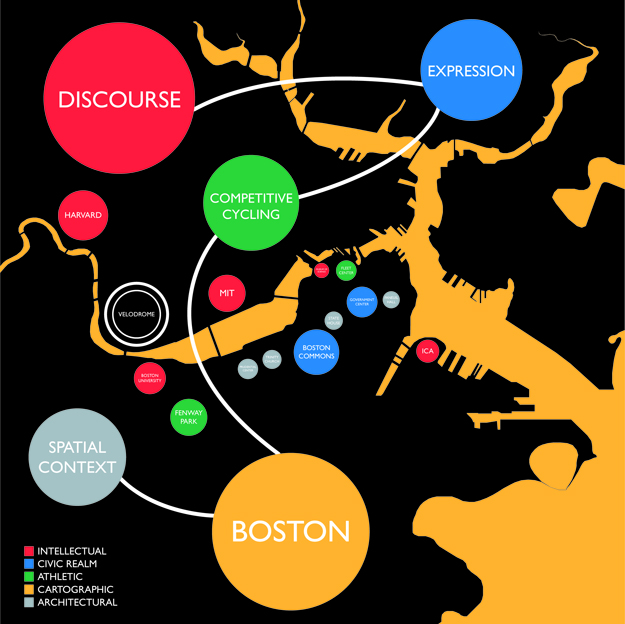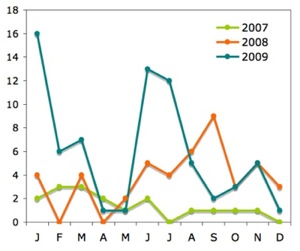After contemplating doing so for a long time, I finally jumped into the blog world back in January 2007, when I debuted “Urban Thinking” with a simple Blogger template and anticipation of one day having an active, credible blog that somebody besides myself might actually find interesting to read. Since then I’ve had the opportunity to document many of my ideas and thoughts into words, which is perhaps the most rewarding. As an undergraduate student in architecture and potential future grad student in urban planning, I believe it is important to think critically about the built environment and society around me and be able to analyze and draw conclusions on such things. I’ve found blogging to be the perfect medium for me to do this.
The focus of my blog from the beginning has always been on my interests in architecture, cities, transit and all related things. Since I can remember I have always been interested in cities and the characteristics that make them what they are. I’ve known since before high school what I wanted to go to school for and become – an architect. I hold a very urbanist point of view and am quite critical of suburban design, sprawl, and the relentless catering to the personal automobile. However, I have not always held these views. Many things have changed and shaped my views on what a good city is and how we should grow and develop our communities. A big influence, I believe, has been blogging, more specific the blogs of others who spoke out on these issues and went against the grain. They revealed to me how blindly accepting I was to bad design in my environment and helped me become the better-informed urbanist I am today.
My first exposure to blogs was probably about two to three years ago with hardcore urbanist, Steve Patterson’s “Urban Review STL” blog, which I came upon numerous times by Googling “urban.” At first I mostly looked at the pictures but eventually started reading the commentary as well. I found Steve’s nit-picky criticism of a seemingly fine looking, suburban Walgreen’s in Springfield, Missouri very compelling. At the time I hadn’t yet realized the many drawbacks and flaws of suburban design. Admittedly, I still think the Walgreen’s looks pretty good (exception for the parking lot in front), but I now understand and agree with Steve’s persistence for accessibility and the importance of good urban design in our cities and communities.
After my freshman year of college at North Dakota State University, I decided to transfer to the closer to home Iowa State, although proximity to home had nothing to do with it. Over spring break I had visited my friend in Washington, D.C., where he was attending his freshman year at George Washington University. Though I had been to DC twice before when my brother was living in nearby Laurel, Maryland, this visit was much more impressive. The week was awesome – getting to spend so much time right in the city, exploring some great urban neighborhoods, and having to rely entirely on public transportation. Realizing my dissatisfaction with the urbanity of Fargo, North Dakota, I immediately began looking for other schools. Since I was already drawn to the DC area, the University of Maryland became of interest, being the only public university with an architecture program. I returned to NDSU after spring break, pondering my options, ultimately concluding that Iowa State was the most feasible and reasonable choice. Aside from having a highly-regarded (and ranked) program that I convinced myself was important, Iowa State also offered programs in Community and Regional Planning, a study that increasingly intrigued me. Unlike NDSU, Iowa State was a “big school,” which I figured could make up for some of the lacking “big city” urbanism.
During my first year at Iowa State I began reading and looking for blogs more regularly. I also officially decided I wanted to go to grad school, likely after discovering there was no way to double major or even minor in CRP at ISU. Additionally I would now only receive a Bachelor of Architecture degree from Iowa State, whereas NDSU had just transitioned to a 5 year Masters program, an increasing trend among architecture schools nationwide. After searching the internet for different planning grad schools I inevitably came back to University of Maryland. I soon became quite adamant about my aspirant future grad school, quite similar to the way I had once felt about NDSU back in high school, and perhaps for a short time about Iowa State.
One day while investigating more about the university and College Park, I came across a fairly new community development blog called “Rethink College Park.” At first I was excited to see all the development and improvements happening in College Park and eventually caught on to certain complexities facing the community. Nonetheless, I was happy to see all the plans and proposals for the University’s East Campus initiative and future Purple Line light rail that will transverse campus.
By way of Rethink College Park, I discovered another great blog, that of RTCP co-founder and UM urban planning grad student Rob Goodspeed, “The Goodspeed Update.” His data-based approach to analyzing urban spaces and services, graphs and charts included, was incisive as another dimension of understanding and evaluating urbanism. In addition to writing about DC, Rob also has informative posts on urban planning and blogging – certainly of interest to a new blogger and aspiring planner myself.
Furthermore I have discovered additional blogs and websites of like topics that have come to serve as precedents for my own blog. They have all been influential to me in some way or another in my continual effort to better understand and examine the great delight that I find in cities and urban spaces.
In January 2007, during my second semester at Iowa State, I was hired as a part-time transit driver for CyRide, the city-university partnership transit agency. I have always been compelled by various forms of transportation, especially passenger rail, but this inevitably sparked an increased interest in transit and particularly buses. The job is great. I have gotten to know the regulars and enjoy interacting with a diverse crowd of passengers. I feel more connected than ever to the Ames community, which is something the average ISU student probably cannot say. The job also affords me invaluable insight and experience into the transit industry that will no doubt be beneficial in my future career. From now on, I am officially a transit fan.
Now it is 2008, and I’ve just completed my third year of college. My views on urban issues have changed for the better over the past three years as I have become more informed and concerned, though my passion for cities has always existed. As said, I owe much to the great blogs discussed above, but also the great cities and urban spaces I’ve had to good fortune to visit. Washington, D.C., Baltimore, Chicago and so on – all fascinating studies. My goals are to further my understanding of cities, develop my design communication skills, and continue thinking urban. A better understanding of urbanism will ultimately allow me to design better studio projects in the three years remaining of my undergraduate education. Through all this, my blog will be key and I hope to produce some exceptional posts that might inspire someone in the way others have inspired me.


Two Years of Urban Thinking
Happy New Year! As 2008 came to an end, I look back at the past two years I’ve been blogging. Urban Thinking officially went online in January 2007, and has taken some time to develop. The first year was slow and inconsistent. With only 17 posts for the entire year of 2007, some month-long spans of time went by with no new entires. I’m proud to say, however, 2008 was a year of great growth and development of my blog – both in content and frequency of posting, as well as increased readership.
This past year I wrote 45 entries, a 265 percent increase from 2007. Averaging 3.75 posts per month, frequency still fluctuated with spotty posting in the first months. The June flooding in Cedar Rapids provided a great deal of content, resulting in a steady stream of posts through the fall.
Around April 2008, I switching operations to WordPress from Blogger – allowing a lot more customization, features, and available design templates. Over the summer I also added Google Ads and began collecting visitor statistics with Sitemeter. Next I plan an internal redesign of the site and development of a comprehensive online portfolio of my studio work at Iowa State.
I hope to continue developing Urban Thinking in the new year, increase and maintain a steady frequency of posts and attract more readers – and more discussion. The great thing about blogs is that they are interactive, two-way; readers can contribute through comments and share their views as well as the author. The dynamic power of blogs is endless and quickly gaining popularity and respect as a significant medium of communication.
If you regularly or occasionally visit my blog, or even if this is your first time reading, I’d love hearing from you! If you enjoy the content and topics I discuss, even if you don’t, let me know. What else would you like to see here? I’m particularly interested in readers that I do not know personally – how did you come across my site? Do you plan to return to read more? Would you engage in discussion? Any feedback would be greatly appreciated.
Thanks for reading and please leave a comment!